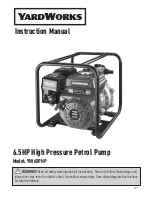
www.evolutionpowertools.com
www.evolutionpowertools.com
18V LI-ION BATTERY JIGSAW
12
down. Position 1 is the least aggressive of
the orbital cutting actions, with position 3
being the most aggressive.
The Table below gives some typical examples
of the use of the orbital cutting facility.
We recommend that the operator always
practices on a piece of unwanted material to
determine the most suitable selection for the
task at hand.
GENERAL CUTTING ADVICE
Note:
Always ensure that the footplate of the
jigsaw is in close contact with the workpiece
throughout the cutting procedure. If the
footplate is allowed to ‘lift’ away from the
workpiece operator control and accuracy will
be compromised.
• Clearly mark out the cutting line to be
followed on the workpiece (use a pencil or
other suitable marking device).
• Small workpieces should be secured in a
vice or clamped to a workbench. Check
that the passage of the blade is not
obstructed.
• Larger workpieces should be clamped to
sawhorses or similar. Check that the
passage of the blade is not obstructed.
• Set the Cutting Action Selection Lever to
the desired position.
• Align the saw with the cutting line and rest
the front of the footplate on the workpiece.
Note:
Ensure that the blade is not in contact
with the workpiece at this stage.
• Switch the machine ‘On’ and gently feed
the jigsaw into the workpiece. Be careful to
hold the jigsaw firmly and keep full control
as the blade contacts the workpiece.
• Adjust the speed of the blade as necessary
to achieve optimum cutting performance.
• Use the Laser guide if necessary, but only
on non-reflective materials.
Note:
Do not force the blade. Let the blade
do the work by adjusting the speed and feed
rates to achieve best performance.
CUTTING METAL
When cutting any metal a suitable cutting
lubricant/coolant should be used. Cast Iron
and Brass can be cut without a cutting
lubricant. Always use a blade that is capable
of cutting metal, and secure the workpiece
securely, if practicable, in a vice or similar
clamping device.
WARNING:
When cutting metal the Cutting
Action Selection Lever must be set to the ‘0’
position.
ANGLE CUTTING
FOOTPLATE ANGLE ADJUSTMENT
Note:
The footplate is factory set and
adjusted so that the blade cuts at 90
0
to the
footplate.
The footplate may be tilted to allow an angle
of up to 45
0
to either side with positive
location stops at 15
0
, 30
0
and 45
0
To adjust the footplate:
• Remove the battery from the jigsaw.
• Loosen the two hex-headed screws
underneath the footplate using a suitable
allen key.
(Fig. 7)
13
•Tilt the footplate to the desired angle
(Fig. 8)
• To engage one of the positive stops it will
be necessary to slide the footplate
forwards or backwards depending on the
stop required.
• Tighten the two hex-headed screws
carefully so as not to damage the threads.
• Re-install the battery.
Follow the steps as for General Cutting as
outlined previously.
Note:
Angled cutting, whatever the
material, is always more difficult than
general straight cutting. With angled cutting
it is very important to allow the saw blade
to do the work. Do not ‘force’ the blade. A trial
run on unwanted material to determine the
best combination of blade feed and speed is
recommended.
Return to the factory setting when angled
cutting is completed. Recheck the security of
the blade.
CUTTING CIRCLES OR CURVES
When cutting curves, particularly tight curves,
start with a reasonably slow speed, and
gradually increase the speed until the optimum
performance is achieved.
Do not force the blade, as in curved cutting this
can lead to the blade deflection, and possible
blade breakage.
To cut a circle from a workpiece:
• Mark out the circle in the required postion.
• Drill a ø12 mm hole near the centre of the
hole.
• Insert the jigsaw blade into the ø12 mm
hole. Ensure that there is clearance
between the blade and the workpiece.
• Begin cutting towards the outside of the
circle, slowly in a spiral fashion, until the
blade is following the required cutting line.
• Advance the jigsaw slowly to avoid cutting
a slanted surface or experiencing blade
deflection.
BLADES
Choose blades carefully. Use only a blade that
is suitable for this machine and for the material
to be cut.
The ability of any jigsaw to follow curves,
provide smooth finishes or faster cutting is
directly related to the type of blade employed.
MAINTENANCE
Your Evolution Jigsaw requires no major
additional lubrication or maintenance.
Occasionally apply a drop of light machine oil
to the blade guide spindle. There are no user
serviceable parts in your Evolution Jigsaw, or
Evolution 18v Charger.
POSITION
TYPICAL APPLICATION
0
Thin materials. Fine cuts. Tight curves. All metals
1
Hard materials such as chipboard, MDF, Plywood etc
2
Thick materials such as constructional timber and plastic
3
Fast cuts when cutting with the grain in softwood material
FIG: 8
FIG: 7



































